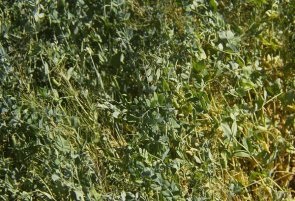Cover crops: field peas
Information on the benefits and growth habits of field peas planted as a cover crop.
Description

Figure 1. Cover crop of field peas.
Family
- Winter annual legume
- Pisum sativum L.
Growth habits
Germination
- Large, spheroidal-shaped seeds
- Germinates best in cool (4.5°C) moist — yet well-drained conditions
- Germination is higher at warmer (24°C) temperatures — but seeds are at a higher risk of infection from soil-borne diseases
Top growth
- Viney, growth with weak stems — may reach a height (or length) of 1 m
- Growth is rapid under cool conditions
- Requires a supporting crop (like oats or rye) to stand
- Flowers in pairs - white, pink or purple
Root system
- Shallow root system
- Susceptible to drought
Overwintering
- Can withstand freezing temperatures (-12°C) but do not overwinter consistently — particularly in areas of low snowfall and extended temperatures
Site suitability
- Grows best on well-drained loamy and clayey soils
- Does not do well on poorly drained soils and droughty, sandy and gravelly soils
- Has a pH range of 6.0 to 7.5
- Prefers fertile soils
Control options
- Mow and incorporate after flowering
- Chemical control
Sensitivity to herbicides
- Certain varieties tolerant of MCPA and metribuzin
Weed control
- Peas are generally not as effective as grass cover crops for weed suppression, particularly under warm conditions.
- Use narrow rows and appropriate agronomic practices to establish a vigorous crop canopy as soon as possible.
- Registered herbicides for Austrian winter peas include Basagran and Tropotox Plus.
- Registered broadleaf herbicides include Treflan, Tropotox Plus and Basagran as well as Poast for grasses.
Benefits and cautions
Nutrient management
- Fixes nitrogen — adding up to 100 lbs/ac
Pest management
- Can release an allelopathic compound as a root exudate (Beta alanine) which has been documented to cause reduced growth in some grass seedlings and germinating lettuce
- Peas are an attractive host crop for nematodes
- Peas often have high aphid populations, but can also provide cover for a number of beneficial insects, including predatory mites and lady beetles
- Bees are attracted to fields of flowering peas
- Can reduce incidence of wheat-disease — take-all
Organic matter
- Adds considerable biomass to soil — from the seed and stubble
- Crop residue readily breaks down
- Can be used as feed - either as forage or as dried seed supplement
Getting started
Establishment
- Seeding rates vary with seed size, 100 to 150 kg/ha
- Ensure good soil moisture and seed to soil contact
- Create fine seedbed with smooth surface to ensure uniform planting depth
Cost and availability
- Expensive seed and requires high seeding rates widely available
Updated: May 29, 2024
Published: June 01, 2022